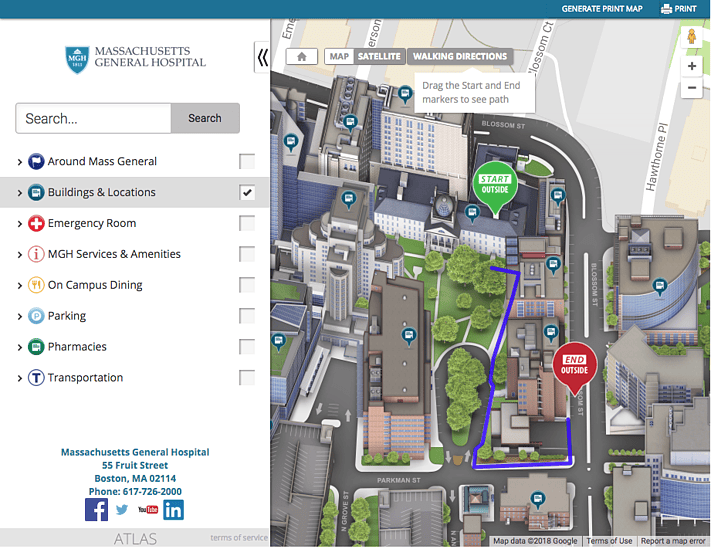The concepts of hospital wayfinding and navigation are more important than you might think! Especially in larger buildings and facilities, it’s very easy to get lost. A hospital serves a variety of patients and needs, but that makes it difficult for individuals to find exactly where they need to go in a short period of time. It’s more than just a theoretical problem. Problems with hospital navigation can lead to lower patient experience and decreased revenue. Fortunately, this can be avoided by thinking strategically.
Hospital maps have long aimed to challenge the issue of wayfinding. In a digital environment, their benefits are becoming even more significant. More specifically, here are 4 reasons your hospital needs an updated campus map to improve its operations
How Campus Maps Improve Hospital Wayfinding and Navigation:
1) Enhance the Patient Experience
First, and perhaps most importantly, hospital maps improve the experience of patients as they navigate around your facility. A friendly front-desk professional can only do so much in guiding them to the right spot. Especially with multi-floor buildings at 100,000 square feet and above, you need continuous reminders of where anyone in need of specific services should go.
The importance of this factor lies in a simple question: what is the ultimate goal of your hospital? Naturally, improving your patients’ help is the most obvious answer. But that includes more than just physical treatments; it also means avoiding stress!
Now, consider the fact that nearly one third of first-time visitors to a hospital get lost. That can lead to missed appointments as well as increased stress levels. Updated campus maps in strategic locations, as well as maps accessible from your website, can solve the issue. Now, your patients will be easily able to find their way to where they need to go. Operations can run more smoothly, but more importantly, the patient experience greatly improves.
2) Account for Mobile Device Preferences
The mobile revolution is already upon us. Chances are that at least on some level, your hospital recognizes the above problem and has placed campus maps in strategic hospital locations. But in an age where most of your patients and visitors check their phone almost every minute, that might not be enough!

Instead, mobile hospital wayfinding is gaining steam. Put simply, your audience should have access to a map of your hospital regardless of their individual location. That might mean placing a virtual map on your website or including it in an app you use to communicate with your visitors. Either way, remote accessibility is key.
Here’s why: smartphones and tables have overtaken desktop in internet usage. A combined almost 60 percent of internet users now prefer their mobile devices. A map that is only available in select places, or is not mobile friendly, may not account for that preference. Build a map that your audience can access easily from any device, and hospital navigation becomes much simpler.
3) Make Necessary Updates in Real-Time
Traditionally, maps tend to be static. They’re drawn once, with the assumption that not much will change and they will remain accurate for the foreseeable future. Unfortunately, in hospitals, that tends not to be the case. Consider the following possible scenarios:
- A department moves to a different floor.
- Two departments switch homes because one is expanding and needs more space.
- A new building with additional services opens to the public.
- New common areas, such as waiting rooms and children’s areas, open.
- Services leave the hospital as they move to a neighboring facility.
These are just a few of the countless scenarios in which a hospital map needs to change. If it’s static, it can send patients and their visitors on a wild goose chase that leads to confusion and frustration. Even your staff may be confused at first and need a map to find their new physical areas of responsibility.
Fortunately, not all maps are static. Building and hosting them digitally means maintaining a degree of adjustment possibility that would not be possible otherwise. Your map can evolve alongside the physical facilities, maintaining accuracy while maximizing patient satisfaction in the process.

4) Add to Your Marketing Collateral
Finally, don’t underestimate the marketing potential of a hospital campus map. Designed the right way, it can serve not just as a helpful functional tool to your current visitors, but also a crucial channel to attract future patients.
Modern, digital maps tend to be interactive. They can easily adjust to patient preferences, thereby offering directions to individual spots, departments, and areas within your hospital campus. That feature alone can help to highlight the breadth of services you have available as potential patients look to your experts for help in their medical problems and questions.
But it doesn’t end there! In addition, you can create layers of your maps that focus on more than just medical services. From available food options to play areas in a children’s hospital, you can highlight the types of features potential patients and their visitors might be interested in.
Once your dynamic map is built, you can use it throughout your various marketing channels. Draw attention to it on social media and highlight it on your website. You can even use it as a helpful tool to guide visitors to the right spots during open houses, health awareness seminars, and other events.
Building a Map that Moves Your Hospital Forward
While most organizations recognize the importance of hospital wayfinding, actually accomplishing this feat tends to be much more complex. You have to account not just for the sheer size of your campus, but also for your audience’s preferences and any real-time updates that might be necessary.
Fortunately, the right map and hospital wayfinding solution allows you to do all of the above. It helps you move your hospital forward, maximizing the potential of your digital channels by tapping into the ways in which your audience behaves today. At the same time, it can also improve your hospital’s operations while minimizing waste in the process. In short, a digital map is absolutely essential for modern hospitals looking to attract and retain their patients.

